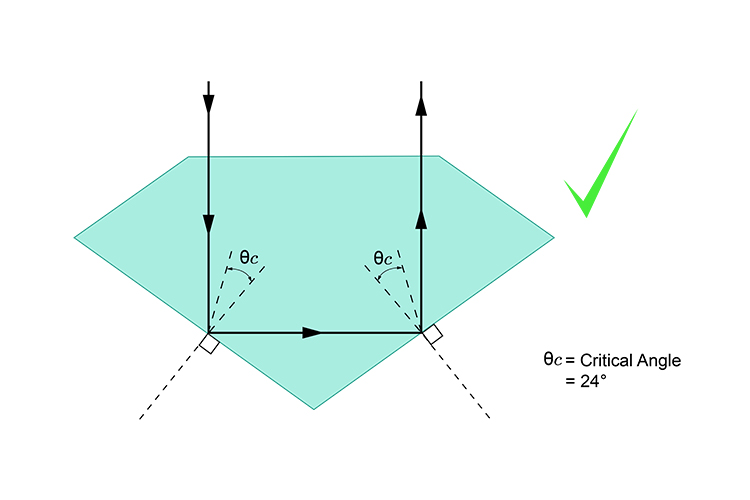When a ray of light travels from denser to rarer medium it bends away from the normal and as the angle of incidence in denser medium increases, the angle of refraction in the rarer medium also increases and at a certain angle, the angle of refraction becomes 90o, this angle of incidence is called critical angle (θc).

From Snell’s law,
\(n_1 \sin{\theta_1} = n_2 \cos{\theta_2}\)Here,
n1 = refractive index of water
θ1 = angle of incidence
n2 = refractive index of air
θ2 = angle of refraction
so,
• Sin(θc)/ Sin(90) = n2/n1
• Critical angle (θc)= arcsin(n2/n1)
Example:
Refraction from water to air (refractive index of water is 1.33)
θc = arcsin(1/1.33) = 49 degrees
If the angle of incidence of the light ray exceeds the θc then the light ray comes back into the same medium after reflection at the interface. This is called Total internal reflection (TIR).
Applications
- The concept of θc is the basis for the construction and working of fiber optic cables.
- Fiber optics using glass or plastic are used in telecommunications for telephone calls, video signals, and computer data. useful in medical diagnostics: colonoscopy, endoscopy, bronchoscopy.
- Working of total internal reflection fluorescence microscope.
- Multi touch screens.
- Prismatic binoculars.
Critical Angle in Diamond

From the above equation for the critical angle.
θc = arcsin(n2/n1)
Refractive index of diamond is 2.42
So,
θc (Critical Angle of Diamond) = arcsin(1.000/2.42) = 24.4 degrees
Solved Examples
Question 1. Critical angle of glass is θ1 and that of water is θ2. The θc for water and glass surface would be (µg = 3/2, µw = 4/3)
- less than θ2
- between θ1 and θ2
- greater than θ2
- less than θ1
Solution.
sin θ1 = 1/µg and sin θ2 = 1/µw
Since, µg > µw, θ1 < θ2
Critical angle θ between glass and water will be given by
sin θ = µw/µg
Or θ > θ2
So we conclude that option (3) is correct.
Question 2. A disc is placed on the surface of a pond. The refractive index of the pond is 5/3. A source of light is placed 4m below the surface of liquid. Find the minimum radius of the disc so that the light doesn’t come out?
Solution.

From the figure we can notice that the direction of light ray at the edge of disc is parallel to light surface, when the incident ray makes θc.
After the edge we can note that light rays will be reflected due to total internal reflection and the whole radiation from light source is blocked
Hence the angle ‘i’ shown in the figure should be the θc.
For the θc we have,
sin i = 1/μ = 3/5
tan i = 3/4 … (1)
From the figure, we can conclude that tan i = r/4 … (2)
hence from (1) and (2), the required radius = 3 m
FAQs
Yes, the critical angle depends on the colour of light
Red colour light has higher critical angle
Here,
v = ?, C = 45∘
μ = 1/sinC = 1/sin45∘ = √2
v(speed of light ) = c/μ = 3×108m/s/ √2
v = 2.12×108 m/s
The speed of light in a medium whose critical angle is 45 degree is 2.12×108m/s
